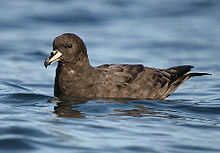| Westland petrel | |
|---|---|

| |
| Scientific classification | |
| Domain: | Eukaryota |
| Kingdom: | Animalia |
| Phylum: | Chordata |
| Class: | Aves |
| Order: | Procellariiformes |
| Family: | Procellariidae |
| Genus: | Procellaria |
| Species: | P. westlandica
|
| Binomial name | |
| Procellaria westlandica Falla, 1946
| |

| |
| Westland petrel range | |
| Synonyms[3] | |
| |
The Westland petrel (Procellaria westlandica), (Māori: tāiko), also known as the Westland black petrel, is a moderately large seabird in the petrel family Procellariidae, that is endemic to New Zealand. Described by Robert Falla in 1946, it is a stocky bird weighing approximately 1,100 grams (39 oz), and is one of the largest of the burrowing petrels. It is a dark blackish-brown colour with black legs and feet. It has a pale yellow bill with a dark tip.
This species spends most of its life at sea but returns to land to breed. When at sea, it ranges across areas of the Pacific and Tasman seas around the subtropical convergence and migrates east to South American waters during the non-breeding season. They feed on fish, squid and crustaceans. This species is also known to be an opportunistic feeder, scavenging fish waste discarded by hoki fishers.
The only known breeding colonies of the Westland petrel are in New Zealand, in a small area of forest-covered coastal foothills between Barrytown and Punakaiki on the South Island's West Coast. The birds nest in burrows excavated into hillsides and slopes, and exhibit natal philopatry, that is they return to their natal colony to breed. The loss of a breeding colony can therefore have severe consequences for the population. The total area of all breeding colonies combined is only about 16 hectares (40 acres). In 2014, the breeding colony areas suffered extensive damage from landslips and tree fall during the tail-end of Cyclone Ita. Other significant potential threats to the breeding colonies are predation by feral pigs and vagrant dogs from nearby settlements.
As of 2021, the International Union for Conservation of Nature classified this species as endangered, and the New Zealand Department of Conservation classified this species as "At Risk: Naturally Uncommon" under the New Zealand Threat Classification System.

